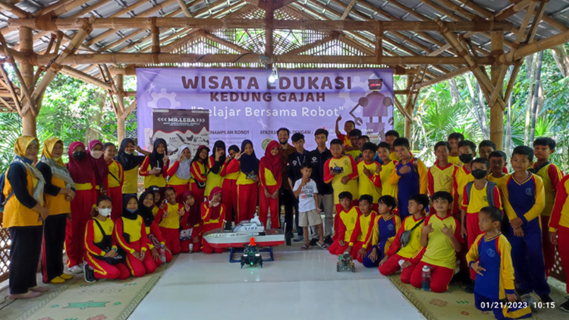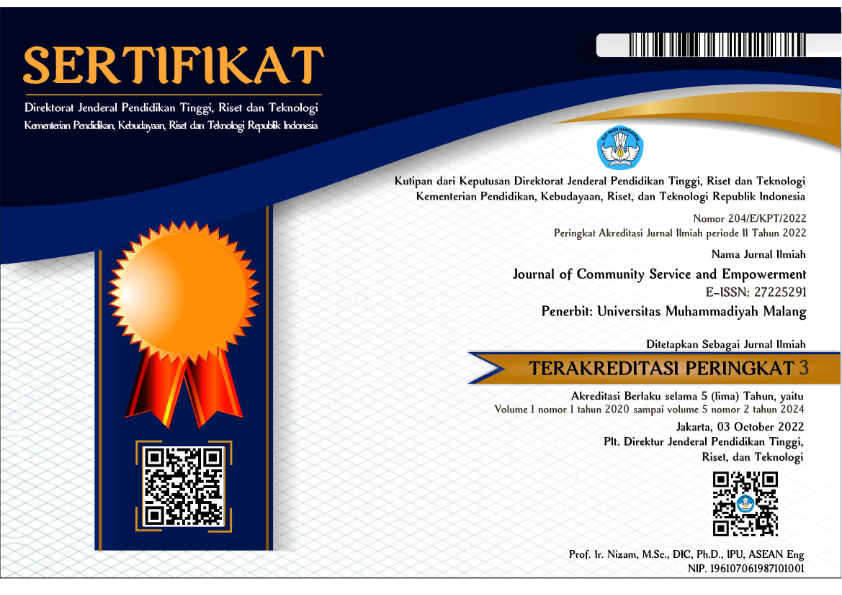Tourism assistance through an example of content innovation programs at Kedung Gajah Sentolo: A robot demonstration.
DOI:
https://doi.org/10.22219/jcse.v4i2.24995Keywords:
tourism, recovery, sustainability, robot demonstration, financial benefitAbstract
The recovery programs of a tourism sector attract huge attention currently. After relaxation of travel restrictions, tourism stakeholders carry out some crucial actions. It includes the concept of participation of local authorities and residents. They formed groups of people who care about tourism “pokdarwis (kelompok sadar wisata)”. Some community service programs have also contributed to the development. Those programs mostly provided training for tourism stakeholders such as managing a tourist attraction and digital marketing. Rarely, the program includes a real case of tourism content innovation how to attract visitors. This community service program took place in “Kedung Gajah” in Sentolo village and in collaboration with Pokdarwis Gerbang Sentolo. As a new tourism object, Kedung Gajah Sentolo requires some views of content innovation, and its operator needs to expand its visitor number. Therefore, this program was intended to provide an assistance to solve both problems. But, beside an assistance, this program also gave a real event. Three main steps were done including observations, coordination between the community service team and the operator of Kedung Gajah and performing a robot demonstration. The observation step resulted some recommendation on the development of Kedung Gajah. Furthermore, in the period of preparation, at least five meetings were conducted to exchange and share information. Finally, the robot demonstration could attract more than 500 people visited the object and these visitors gave benefit to the turnover more than five million rupiah from culinary in estimation.
Downloads
References
Anna Maria Stalmirska. (2021). Local food in tourism destination development: The supply-side perspectives, tourism planning & development, https://doi.org/10.1080/21568316.2021.1928739
Arif, M., Behzad, H.M., Tahir, M. and Li, C. (2022). The impact of ecotourism on ecosystem functioning along main rivers and tributaries: Implications for management and policy changes. Journal of Environmental Management, 320 https://doi.org/10.1016/j.jenvman.2022.115849
Baruah, T.D. (2012). Effectiveness of social media as a tool of communication and its potential for technology enabled connections: A micro-level study. International Journal of Scientific and Research Publications, 2(5), 1-10
Behsudi, A. (2020). Tourism-dependent economies are among those harmed the most by the pandemic. https://www.imf.org/en/Publications/fandd/issues/2020/12/impact-of-the-pandemic-on-tourism-behsudi - Accessed Jan 2023
Eryani, I.G.A.P., Arthana, I.N.N. & Astiti, N.M.A.G.R. (2021). Development Zoning of Bindu
River ecotourism based on eco culture. Civil and Environmental Science Journal (Civense), 4(2), 183-191. doi:
https://doi.org/10.21776/ub.civense.2021.00402.8
Fajri, H., Permana, I., Yuliarti, & Wahyuni, N. (2022). Peningkatan keterlibatan stakeholder dalam upaya pembangunan wisata nagari. Jurnal Inovasi Hasil Pengabdian Masyarakat (JIPEMAS), 5(1), 221–233. https://doi.org/10.33474/jipemas.v5i2.14055
Fitriastuti, F., Ginting, A., & Widiyanti, B. N. (2022). Wisata edukasi dan outbond lembah papah berbasis digital marketing di Desa Sentolo Kulon rogo pada masa pandemi covid-19. Journal Adarma, 9(2), 1 – 11. https://e-journal.janabadra.ac.id/index.php/adarma/article/view/2333
Hsu, C., Lin, H. and Jhang, S. (2020). Sustainable tourism development in protected areas of rivers and water sources: a case study of jiuqu stream in China. Sustainability, 12(13), 5262. https://doi.org/10.3390/su12135262
KR Jogja. (2020). Dampak Covid-19, Pariwisata DIY Rugi Rp 67 M. https://www.krjogja.com/berita-lokal/read/307315/ dampak-covid-19-pariwisata-diy-rugi-rp-67-m
Liu, YL., Chiang, JT. & Ko, PF. The benefits of tourism for rural community development. Humanit Soc Sci Commun, 10, 137 (2023). https://doi.org/10.1057/s41599-023-01610-4
Manhas, P.S., Manrai, L.A, & Manrai, A.K. (2016). Role of tourist destination development in building its brand image: A conceptual model. Journal of Economics, Finance and Administrative Science, 21, 25-29. http://dx.doi.org/10.1016/j.jefas.2016.01.001
Novianto, R. D. (2023). Aktivitas wisata naik signifikan usai PPKM dicabut, Menparekraf: Okupansi hotel capai 100%. https://ekbis.sindonews.com/read/1009967/34/aktivitas-wisata-naik-signifikan-usai-ppkm-dicabut-menparekraf-okupan si-hotel-capai-100-1675119715
Orîndaru A, Popescu M-F, Alexoaei AP, Căescu Ș-C, Florescu MS, Orzan A-O. (2021). Tourism in a post-Covid-19 era: Sustainable strategies for industry’s recovery. Sustainability, 13(12), 6781. https://doi.org/10.3390/su13126781
Osei, G. B. & Nyarko, A. J. (2022). Health and safety-related issues at lake bosometwe, Ghana. International Journal of Health Management and Tourism, 7(1), 116-139. https://dergipark.org.tr/en/pub/ijhmt/issue/69029/1092133
Pratt, Stephen. (2022). Can tourism contribute to the sustainable development goals? Evidence from Pacific Island Countries & Territories. International Marketing Journal of Culture and Tourism (IMJCT), 1, 45-61. 10.33001/18355/IMJCT0102.
Purdey, Jemma. (2022). Bali’s pandemic, its impacts and legacies. https://www.insideindonesia.org/bali-s-pandemic-its-impacts-and-legacies - Accessed Jan 2023
Ritchie, J.R., Tung, V.W., & Ritchie, R.J. (2011). Tourism experience management research: Emergence, evolution and future directions. International Journal of Contemporary Hospitality Management, 23, 419-438.
Sarmiadi, Yanita, N., & Suryani, Y. (2021). Pelatihan Pengelolaan Desa Wisata Bagi Kelompok Sadar
Wisata Saiyo Desa Tungka Selatan Kecamatan Pariaan Utara Kota Pariaman. Jurnal Abdimas: Pengabdian dan Pengembangan Masyarakat, 3(1), 32 – 35. https://ejournal2.pnp.ac.id/index.php/jppm/article/view/518.
Scott, D. (2021) Sustainable tourism and the grand challenge of climate change. Sustainability, 13(4), 1966. https://doi.org/10.3390/su13041966
Sharpley, R. and Pearce, T. (2007). Tourism, marketing and sustainable development in the english national parks: the role of national park authorities. Journal of Sustainable Tourism, 15(5), 557-573. https://doi.org/10.2167/jost613.0
Sudarti, S., & Triyono, M. B. (2022).Strategic management of local potential-based entrepreneurship through community empowerment on fish attractions Bendhung Lepen in Mrican Village Yogyakarta. Journal of Community Service and Empowerment, 3(3), 132-141. https://doi.org/10.22219/jcse.v3i3.20230
United Nations. (2015). Transforming our world: The 2030 agenda for sustainable development, https://sdgs.un.org/publications/transforming-our-world-2030-agenda-sustainable-development-17981 - Accessed May 2023
Wijaya, T. W., Azizah, L. M. ., Iqbal, M. ., & Santika, A. P. (2022). Optimalisasi sistem informasi desa berbasis website sebagai upaya peningkatan sumber informasi terhadap masyarakat. Prosiding Seminar Nasional Program Pengabdian Masyarakat, 5(1). https://doi.org/10.18196/ppm.51.1000
World Bank. (2018). Digital platforms and the future of tourism. https://www.worldbank.org/en/news/feature/2018/ 09/25/digital-platforms-and-the-future-of-tourism-a-world-tourism-celebration - Accessed Jan 2023
Yudhiasta, S., & Mijiarto, J. (2023). Digitalization of tourist attractions: Increasing the capacity of Sunrise Land Lombok tourism workers through digital marketing. Journal of Community Service and Empowerment, 4(1), 95–103. https://doi.org/10.22219/jcse.v4i1.24606
Ulya, A. S., & Santoso, D. B. (2022). Perubahan perilaku konsumsi pada masyarakat Jawa Timur selama masa pandemi Covid-19. Journal of Development Economic and Social Studies, 1 (2), 185-199. http://dx.doi.org/10.21776/jdess.2022.01.2.02.

Downloads
Published
How to Cite
Issue
Section
License
Copyright (c) 2023 Indar Surahmat, Ikbar Kausar Rustan, Satria Giri Kusuma

This work is licensed under a Creative Commons Attribution-ShareAlike 4.0 International License.












